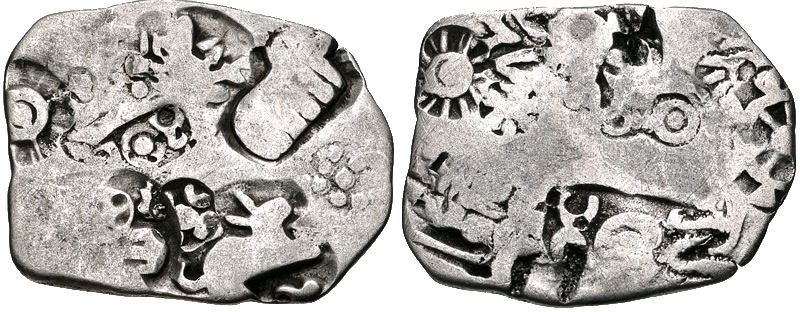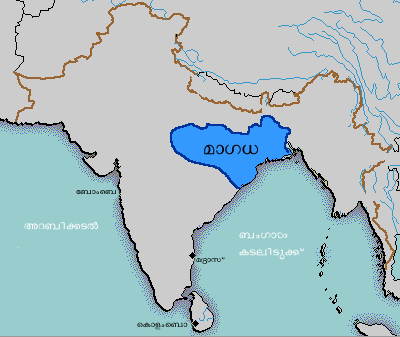|
Shishunaga Dynasty
The Shaishunaga dynasty (IAST: Śaiśunāga, literally "of Shishunaga") is the fourth ruling dynasty of Magadha, an empire of ancient India. According to the Hindu ''Puranas'', this dynasty was the second ruling dynasty of Magadha, succeeding Nagadashaka of the Haryanka dynasty. Shishunaga, the founder of the dynasty, was initially an ''amatya'' or "minister" of the last Haryanka dynasty ruler Nāgadāsaka and ascended to the throne after a popular rebellion in c. 413 BCE. The capital of this dynasty initially was Vaishali; but later shifted to Pataliputra, near the present day Patna, during the reign of Kalashoka. According to tradition, Kalashoka was succeeded by his ten sons. This dynasty was succeeded by the Nanda Empire in c. 345 BCE. Establishment According to Buddhist tradition, Shishunaga was ''amatya'' in Haryanka kingdom, who revolted and became the king. Rulers Shishunaga Shishunaga founded his dynasty in 413 BCE with its capital in Rajgir and later Pataliputra (b ... [...More Info...] [...Related Items...] OR: [Wikipedia] [Google] [Baidu] |
Rajgir
Rajgir, meaning "The City of Kings," is a historic town in the district of Nalanda in Bihar, India. As the ancient seat and capital of the Haryanka dynasty, the Pradyota dynasty, the Brihadratha dynasty and the Mauryan Empire, as well as the dwelling ground of such historical figures as The Buddha and The Mahavira, the city holds a place of prominence in Hindu, Buddhist and Jain scriptures. As of 2011, the population of the town was reported to be 71,459 while the population in the community development block was about 88,500. Rajgir was the first capital of the ancient kingdom of Magadha, a state that would eventually evolve into the Mauryan Empire. It finds mention in India's renowned literary epic, the Mahabharata, through its king Jarasandha. The town's date of origin is unknown, although ceramics dating to about 1000 BC have been found in the city. The 2,500-year-old cyclopean wall is also located in the region. The town is also notable in Jainism and Buddhism. It ... [...More Info...] [...Related Items...] OR: [Wikipedia] [Google] [Baidu] |
Puranas
Purana (; sa, , '; literally meaning "ancient, old"Merriam-Webster's Encyclopedia of Literature (1995 Edition), Article on Puranas, , page 915) is a vast genre of Indian literature about a wide range of topics, particularly about legends and other traditional lore. The Puranas are known for the intricate layers of symbolism depicted within their stories. Composed originally in Sanskrit and in Languages of India, other Indian languages,John Cort (1993), Purana Perennis: Reciprocity and Transformation in Hindu and Jaina Texts (Editor: Wendy Doniger), State University of New York Press, , pages 185-204 several of these texts are named after major Hindu gods such as Vishnu, Shiva, Brahma, and Adi Shakti. The Puranic genre of literature is found in both Hinduism and Jainism. The Puranic literature is encyclopedic, and it includes diverse topics such as cosmogony, cosmology, genealogies of gods, goddesses, kings, heroes, sages, and demigods, folk tales, pilgrimages, temples, medic ... [...More Info...] [...Related Items...] OR: [Wikipedia] [Google] [Baidu] |
Ramakrishna Gopal Bhandarkar
Sir Ramakrishna Gopal Bhandarkar ( mr, रामकृष्ण गोपाळ भांडारकर) (6 July 1837 – 24 August 1925) was an Indian scholar, orientalist, and social reformer. Early life Ramakrishna Bhandarkar was born in Malvan in Sindhudurg district of Maharashtra in a Gaud Saraswat Brahmin family. After early schooling in Ratnagiri, he studied at Elphinstone College in Bombay. Along with Mahadev Govind Ranade, Bhandarkar was among the first graduates in 1862 from Bombay University. He obtained his Master’s degree the following year, and was awarded a PhD from University of Göttingen in 1885. Career Ramakrishna Bhandarkar taught at Elphinstone College,(Mumbai) and Deccan College (Pune) during his distinguished teaching career. He was involved in research and writing throughout his life. He retired in 1894 as the Vice Chancellor of Bombay University. He participated in international conferences on Oriental Studies held in London (1874) and Vienn ... [...More Info...] [...Related Items...] OR: [Wikipedia] [Google] [Baidu] |
Wilhelm Geiger
Wilhelm Ludwig Geiger (; ; 21 July 1856 – 2 September 1943) was a German Orientalist in the fields of Indo-Iranian languages and the history of Iran and Sri Lanka. He was known as a specialist in Pali, Sinhala language and the Dhivehi language of the Maldives. He is especially known for his work on the Sri Lankan chronicles Mahāvaṃsa and Cūlavaṃsa and made critical editions of the Pali text and English translations with the help of assistant translators. Life He was born in Nuremberg, the son of an evangelical clergyman, and was educated especially at the University of Erlangen-Nuremberg under the scholar Friedrich von Spiegel. During his studies, he joined the fraternity Uttenruthia. After completing his Ph.D. thesis in 1878, he became a lecturer on ancient Iranian and Indian philology and then a master at a gymnasium. In 1891 he was offered a chair in Indo-European Comparative Philology at the University of Erlangen, succeeding Spiegel. His first published works were o ... [...More Info...] [...Related Items...] OR: [Wikipedia] [Google] [Baidu] |
Hermann Jacobi
Hermann Georg Jacobi (11 February 1850 – 19 October 1937) was an eminent German Indologist. Education Jacobi was born in Köln (Cologne) on 11 February 1850. He was educated in the gymnasium of Cologne and then went to the University of Berlin, where initially he studied mathematics, but later, probably under the influence of Albrecht Weber, switched to Sanskrit and comparative linguistics, which he studied under Weber and Johann Gildemeister. He obtained his doctorate from the University of Bonn. The subject of his thesis, written in 1872, was the origin of the term "hora" in Indian astrology. Jacobi was able to visit London for a year, 1872–1873, where he examined the Indian manuscripts available there. The next year, with Georg Buehler, he visited Rajasthan, India, where manuscripts were being collected. At Jaisalmer Library, he came across Jain Manuscripts, which were of abiding interest to him for the rest of his life. He later edited and translated many of the ... [...More Info...] [...Related Items...] OR: [Wikipedia] [Google] [Baidu] |
Sinhala Language
Sinhala ( ; , ''siṁhala'', ), sometimes called Sinhalese (), is an Indo-Aryan languages, Indo-Aryan language primarily spoken by the Sinhalese people of Sri Lanka, who make up the largest ethnic group on the island, numbering about 16 million. Sinhala is also spoken as the first language by other ethnic groups in Sri Lanka, totalling about 2 million people as of 2001. It is written using the Sinhala script, which is a Brahmic scripts, Brahmic script closely related to the Grantha script of South India. Sinhala is one of the official and national languages of Sri Lanka. Along with Pali, it played a major role in the development of Theravada, Theravada Buddhist literature. The early form of the Sinhala language, is attested as early as the 3rd century BCE. The language of these inscriptions with long vowels and aspirated consonants is a Prakrit similar to Magadhi, a regional associate of the Middle Indian Prakrits that has been used during the time of the Buddha. The closest ... [...More Info...] [...Related Items...] OR: [Wikipedia] [Google] [Baidu] |
Pradyota Dynasty
Pradyota dynasty, also called ''Prthivim Bhoksyanti'' (lit. enjoying the earth), is an ancient Indian dynasty, which ruled over Avanti and Magadha, though most of the Puranas ''(except a manuscript of the Brahmanda Purana, preserved in the University of Dhaka)'' say that this dynasty succeeded the Brihadratha dynasty in Magadha. The dynasty ruled for 138 years. ''Pradyota'' is the founder of the dynasty and ruler of Avanti & Magadha. Pradyota dynasty was Second dynasty who ruled Magadha. Pradyota was son of Pulika (''Punika''), who is said to have killed Ripunjaya of Brihadratha dynasty at Rajagriha, to make his son the king. Pradyota dynasty was preceded by Brihadratha dynasty and succeeded by Haryanka dynasty of Magadha. Pradyota is said to have ruled for 23 years. Palaka's reign started in (659–635 BCE) according to ''Visarasreni'' of Merutunga. He was the son of Chanda Pradyota of Magadha. He is said to have conquered Kosambi. Palaka is said to have ruled for 2 ... [...More Info...] [...Related Items...] OR: [Wikipedia] [Google] [Baidu] |
Indian Subcontinent
The Indian subcontinent is a list of the physiographic regions of the world, physiographical region in United Nations geoscheme for Asia#Southern Asia, Southern Asia. It is situated on the Indian Plate, projecting southwards into the Indian Ocean from the Himalayas. Geopolitically, it includes the countries of Bangladesh, Bhutan, India, Maldives, Nepal, Pakistan, and Sri Lanka."Indian subcontinent". ''Oxford Dictionary of English, New Oxford Dictionary of English'' () New York: Oxford University Press, 2001; p. 929: "the part of Asia south of the Himalayas which forms a peninsula extending into the Indian Ocean, between the Arabian Sea and the Bay of Bengal. Historically forming the whole territory of Greater India, the region is now divided into three countries named Bangladesh, India and Pakistan." The terms ''Indian subcontinent'' and ''South Asia'' are often used interchangeably to denote the region, although the geopolitical term of South Asia frequently includes Afghanist ... [...More Info...] [...Related Items...] OR: [Wikipedia] [Google] [Baidu] |
Vajjika League
The Vajjika (Pali, Pāli: ) or Vrijika (Sanskrit: ) League, Confederacy, or Sangha, also called simply Vajji (Pali, Pāli: ) or Vriji (Sanskrit: ), was an ancient Indo-Aryan peoples, Indo-Aryan tribal league which existed during the later Iron Age in India, Iron Age period in north-east South Asia. Constituent tribes The Vajjika League were a league of republican tribal states under the leadership of the Licchavi (tribe), Licchavikas centred around the city of Vaishali (ancient city), Vesālī. The other members of the league were the Videha, Vaidehas in the Mithila (region), Mithila region, the Nāya, Nāyikas (Skt. *Jñātrika) of Kuṇḍapura, and the Vajji (tribe), Vajji tribe proper, who were dependencies of the Licchavikas. The Malla (tribe), Mallakas, who were organised into two separate republics, were also part of the Vajjika League, although they were not dependencies of the Licchavikas and therefore maintained their independence and sovereign rights within the confe ... [...More Info...] [...Related Items...] OR: [Wikipedia] [Google] [Baidu] |
Bihar
Bihar (; ) is a state in eastern India. It is the 2nd largest state by population in 2019, 12th largest by area of , and 14th largest by GDP in 2021. Bihar borders Uttar Pradesh to its west, Nepal to the north, the northern part of West Bengal to the east, and with Jharkhand to the south. The Bihar plain is split by the river Ganges, which flows from west to east. On 15 November 2000, southern Bihar was ceded to form the new state of Jharkhand. Only 20% of the population of Bihar lives in urban areas as of 2021. Additionally, almost 58% of Biharis are below the age of 25, giving Bihar the highest proportion of young people of any Indian state. The official languages are Hindi and Urdu, although other languages are common, including Maithili, Magahi, Bhojpuri and other Languages of Bihar. In Ancient and Classical India, the area that is now Bihar was considered the centre of political and cultural power and as a haven of learning. From Magadha arose India's first empire, ... [...More Info...] [...Related Items...] OR: [Wikipedia] [Google] [Baidu] |
Haryanka Kingdom
The Haryanka dynasty was the third ruling dynasty of Magadha, an empire of ancient India, which succeeded the Pradyota dynasty and Barhadratha dynasty. Initially, the capital was Rajagriha. Later, it was shifted to Pataliputra, near the present-day Patna in India during the reign of Udayin. Bimbisara is considered as the main founder of the dynasty. According to the Buddhist text, the Mahavamsa, Bimbisara was appointed king by his father, Bhattiya, at the age of fifteen. This dynasty was succeeded by the Shishunaga dynasty. Governance The governance structure of Haryanka dynasty is mentioned in ancient texts. They mention ''gramakas'' (village headmen) who headed village assemblies and ''mahamatras'' (high-ranking officials) who had executive, judicial and military functions. Historically, this period coincided with the Achaemenid conquest of the Indus Valley during the rule of Darius I from about 517/516 BCE. Rulers Bimbisara Bimbisara reigned from 545 to 493 BCE. Th ... [...More Info...] [...Related Items...] OR: [Wikipedia] [Google] [Baidu] |
Nanda Empire
The Nanda dynasty ruled in the northern part of the Indian subcontinent during the fourth century BCE, and possibly during the fifth century BCE. The Nandas overthrew the Shaishunaga dynasty in the Magadha region of eastern India, and expanded their empire to include a larger part of northern India. Ancient sources differ considerably regarding the names of the Nanda kings and the duration of their rule, but based on the Buddhist tradition recorded in the '' Mahavamsa'', they appear to have ruled during ''circa'' 345–322 BCE, although some theories date the start of their rule to fifth century BCE. The Nandas built on the successes of their Haryanka and Shaishunaga predecessors, and instituted a more centralised administration. Ancient sources credit them with amassing great wealth, which was probably a result of introduction of new currency and taxation system. Ancient texts also suggest that the Nandas were unpopular among their subjects because of their low status birth, e ... [...More Info...] [...Related Items...] OR: [Wikipedia] [Google] [Baidu] |






_1_by_N._A._Naseer.jpg)

